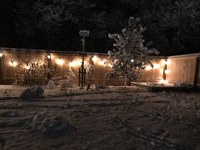Dakota Gardener: Spend More Time Outside With Garden Lighting
(Click an image below to view a high-resolution image that can be downloaded)
By Carrie Knutson, NDSU Extension Agent, Grand Forks County
As the seasons change, we try to spend the most time we can outside before darkness forces us indoors.
Last year, I purchased outdoor lights to hang on a portion of our backyard fence. The additional lighting allowed us to enjoy our yard after dark. My family loved the lights so much that I went back and bought more.
Adding outdoor lights might entice you to spend more time enjoying your outdoor space this summer and into the fall.
When designing outdoor lighting, we don’t have “rules,” but design elements are guides to help us make a visually pleasing design. A few of the design elements to think about are balance, rhythm, simplicity, unity and accent.
For example, create unity with fixtures that have the same type of finish and light color.
Create rhythm by using pools of light, not constant brightness. Space lights so that you are guided around the outdoor space.
Balance light so areas of your outdoor space are not left in the dark.
Use multiple lights to accent the focal point of your outdoor space. Focal points could be prize plants, artwork or a seating area. If you would like to use a tree as a focal point, make sure to illuminate the trunk as well as the foliage. Otherwise, the foliage will look like it is floating.
You can find a variety of types of lights on the market for outdoor use. Canopy lights reflect down onto surfaces and are used in gardens or to highlight paths. Wash lights provide a soft, diffused light for brightening walls or fences. Bullet lights project a narrow beam of light and are ideal for lighting focal points. String lights also can be used to accent a focal point.
Well lights are buried in the ground and used to brighten the underside of plants. Down lights are located in high places to brighten areas below. Flood lights cast a bright wide beam and are used to light up trees or sides of structures, or for security.
You also have a variety of ways to power lights, from battery and solar power to lights that need electric cables. Do some research and find what is within your capabilities and budget.
My garden lighting is still a work in progress. I need to work on creating balance and unity in my lighting design this summer. How will you add to your outdoor space this summer? Happy gardening!
For more information about gardening, contact your local NDSU Extension agent. Find the Extension office for your county at https://www.ag.ndsu.edu/extension/directory/counties.
NDSU Agriculture Communication - Jan. 26, 2021
Source: Carrie Knutson, 701-780-8229, carrie.knutson@ndsu.edu
Editor: Ellen Crawford, 701-231-5391, ellen.crawford@ndsu.edu




